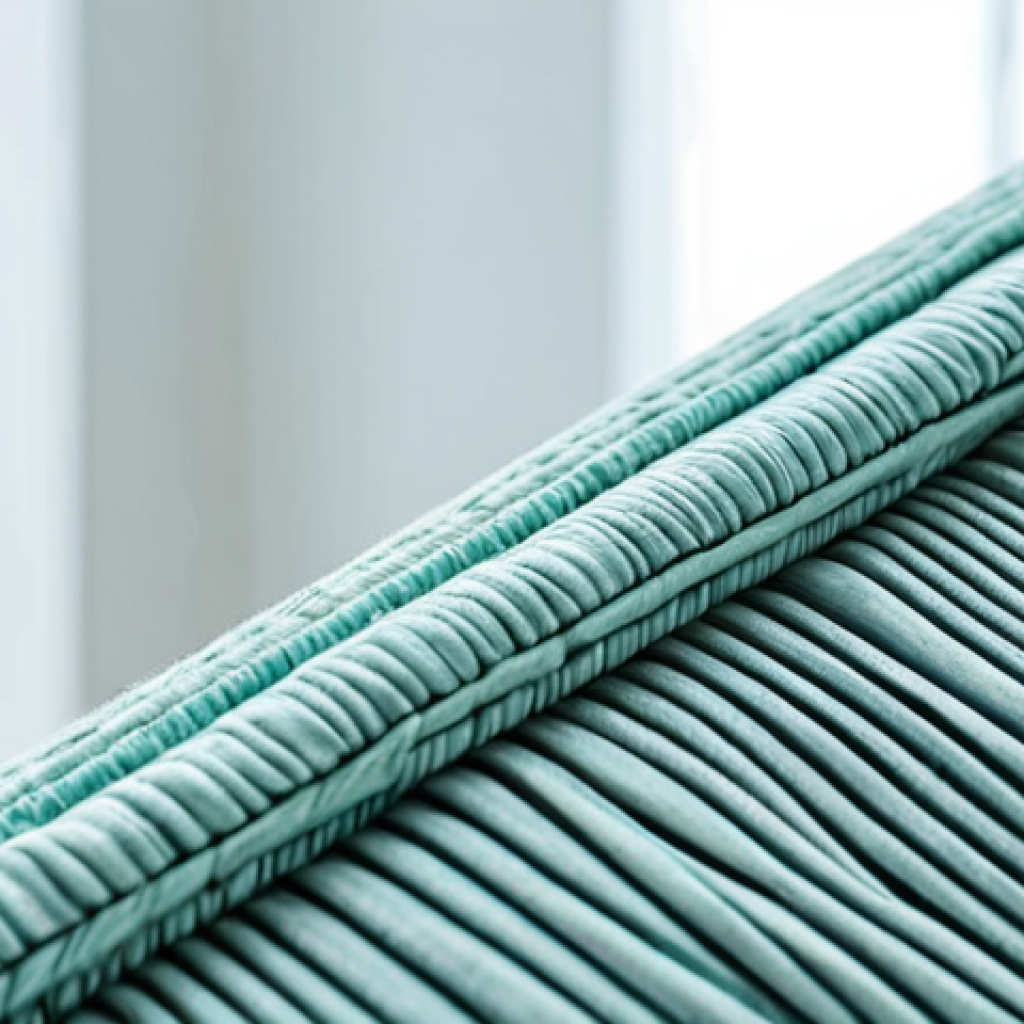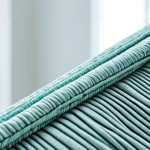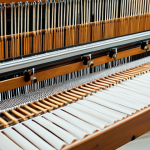When I first considered a career in textiles, I admit, my imagination stretched only as far as fashion week and perhaps some technical fabrics for outdoor gear.
But having spent years observing the industry evolve, what I’ve truly come to realize is how profoundly a qualification in textile engineering—whether a degree or a specialized certification—can redefine your professional trajectory.
We’re not just talking about weaving threads anymore; this field is the backbone of groundbreaking innovation. From developing sustainable materials that could genuinely combat climate change to engineering smart textiles seamlessly integrated into cutting-edge wearable tech, the opportunities are vast and incredibly exciting.
If you’re pondering the true value of diving into this dynamic, forward-looking sector, prepare to be genuinely surprised by the sheer breadth of impact you can make.
Let’s dive deeper below.
The Unseen Revolution: Pioneering Sustainable Textile Innovations

When I first dipped my toes into the world of textile engineering, the concept of “sustainability” was still a niche conversation, often relegated to small, independent brands.
But witnessing the sheer transformation over the past decade has been nothing short of breathtaking. It’s no longer just about recycling old t-shirts; it’s about fundamentally rethinking material lifecycles, from source to end-of-life.
My own work, even observing from the periphery, has shown me how textile engineers are truly on the frontline of developing groundbreaking solutions that promise to drastically reduce our environmental footprint.
We’re talking about innovations that could genuinely shift the needle on climate change, making a profound impact that extends far beyond fashion. It’s a responsibility and an opportunity I find incredibly compelling, knowing that the fibers we engineer today could be the very solutions that protect our planet tomorrow.
This isn’t just about eco-friendly trends; it’s about a deep, systemic overhaul driven by scientific rigor and creative problem-solving, something I’ve come to deeply respect.
Redefining the Supply Chain for a Greener Tomorrow
I remember a conversation with a colleague who had spent years optimizing supply chains for a major apparel company. They candidly shared how challenging it was to track every single fiber, every dye, every drop of water used.
But with modern textile engineering, we’re seeing incredible breakthroughs in transparency and efficiency. Imagine a world where every component of your clothing is traceable, where water usage is minimized, and waste is virtually eliminated.
This isn’t a pipe dream anymore. Textile engineers are now building circular systems, implementing digital tools for supply chain visibility, and innovating processes like waterless dyeing.
It’s a painstaking but deeply rewarding endeavor, as it involves not just technical expertise but also a keen understanding of global logistics and ethical sourcing.
From my perspective, this hands-on involvement in shaping a more responsible industry is one of the most impactful aspects of this field, moving from abstract concepts to tangible, real-world change.
The Promise of Biodegradable and Recycled Fibers
Honestly, the first time I held a fabric sample made from truly biodegradable mushroom-based mycelium, I was astounded by its potential. It felt revolutionary.
For years, our landfills have been choked with synthetic textiles that take centuries to decompose. But now, textile engineers are at the forefront of creating fibers from unexpected, renewable sources – think pineapple leaves, orange peels, or even algae.
Beyond that, the sophisticated processes for recycling post-consumer waste into high-quality new fibers are constantly evolving. It’s not just about shredding old denim; it’s about molecular recycling that breaks down polymers to their basic building blocks, allowing for infinite reuse.
I’ve heard firsthand accounts from researchers describing the painstaking lab work involved, the countless iterations, but also the immense satisfaction of knowing their discoveries could genuinely divert mountains of waste from our precious planet.
It’s a field driven by both scientific curiosity and a profound sense of purpose.
Weaving Intelligence: Smart Textiles and Wearable Technology
When I first started observing this industry, the idea of clothing that could do more than just cover you seemed like something out of a sci-fi movie.
Yet, here we are, in an era where textiles are no longer passive materials but active interfaces. I’ve personally seen prototypes and even commercial products that seamlessly integrate electronics, sensors, and communication capabilities directly into the fabric itself.
It’s a truly fascinating convergence of disciplines – electrical engineering, computer science, and textile innovation all coming together to create something entirely new.
This isn’t just about adding a chip to a jacket; it’s about the fabric *itself* becoming the technology. The possibilities, from personal health monitoring to immersive gaming experiences, feel limitless, and I find myself constantly amazed by the ingenuity driving these advancements.
Beyond Fitness Trackers: Fabric as Interface
You know those clunky fitness trackers that everyone used to wear? Imagine if your entire shirt could do that, imperceptibly, capturing vital signs or even guiding you through a workout.
That’s the reality textile engineers are building. I recall attending a tech expo where a researcher demonstrated a shirt that could precisely measure heart rate, respiration, and even muscle activity without any external devices.
The fabric itself contained the conductive pathways and sensing elements. This isn’t just about convenience; it’s about creating more comfortable, more accurate, and less intrusive ways to interact with technology.
From smart gloves that control virtual reality environments to responsive athletic wear that adapts to your body temperature, the innovation in this space is truly astounding, making technology feel like a natural extension of ourselves.
Health Monitoring and Therapeutic Garments
This is where I feel the profound impact of textile engineering truly shines – in healthcare. I’ve always been intrigued by how technology can improve lives, and smart textiles are doing just that in ways many people don’t even realize.
We’re talking about garments embedded with sensors that can continuously monitor a patient’s glucose levels, detect early signs of cardiac issues, or even provide targeted compression and warmth for therapeutic purposes.
Imagine an elderly relative wearing a comfortable garment that discreetly tracks their well-being, alerting caregivers only when necessary. Or sportswear designed to aid muscle recovery with embedded heating elements.
The precision engineering required to make these textiles durable, washable, and safe for skin contact is immense. It’s a field where expertise directly translates into tangible improvements in quality of life, something that resonates deeply with me.
Unsung Heroes: Textiles in Medical and Healthcare Frontiers
It’s easy to overlook, but the medical field relies heavily on textile innovations, often in life-saving capacities. From the sterile environments of operating rooms to the very stitches that close wounds, textiles are indispensable.
My own perspective on this broadened immensely after a conversation with a biomedical engineer who explained the sheer complexity of developing biocompatible fabrics for internal use.
It’s not just about making something soft; it’s about ensuring it doesn’t cause rejection, can withstand bodily fluids, and provides the necessary structure for healing.
This quiet revolution in medical textiles is constantly pushing boundaries, offering solutions that enhance patient recovery, prevent infections, and provide critical support.
It’s a testament to the fact that textile engineering isn’t just about fashion or home goods; it’s about intricate science with life-changing implications.
Surgical Implants and Wound Care Revolution
Honestly, the idea that a textile could be woven into a human body, remaining there for years, was mind-boggling to me at first. But surgical meshes, artificial ligaments, and even vascular grafts are all products of advanced textile engineering.
These aren’t just simple weaves; they are meticulously designed structures with specific porosity, strength, and biodegradability profiles. For instance, I learned about dissolvable sutures made from specific textile fibers that literally disappear as a wound heals, eliminating the need for removal.
And in wound care, advanced dressings infused with antimicrobial agents or growth factors, all within a textile matrix, are dramatically improving healing times and outcomes for patients.
It’s a delicate balance of material science and biology, and the precision required is extraordinary, making it a truly specialized and impactful area within textile engineering.
Protective Gear for First Responders and Medical Staff
During recent global health challenges, I found myself reflecting on the incredible reliance we have on protective textiles. Think about the hazmat suits, the surgical gowns, and even the specialized masks worn by doctors, nurses, and first responders.
These aren’t just simple fabrics; they are engineered barriers designed to protect against pathogens, chemicals, and extreme temperatures. Textile engineers are constantly innovating in this space, developing materials that are lightweight, breathable, yet impermeable to dangerous substances.
The comfort factor is crucial too, because someone wearing such gear for hours needs to be able to perform their job effectively without overheating or feeling restricted.
From my observation, the dedication to creating these life-saving garments, often under immense pressure, is a huge part of the textile engineering story that often goes untold but is incredibly vital.
From Roads to Skies: Advanced Composites and Automotive Applications
It’s easy to think of a car or a plane as being made of metal and plastic, but the reality, which I’ve discovered through following industry trends, is that textile-based composites are playing an increasingly critical role.
When I first heard about carbon fiber being woven into the structure of high-performance vehicles, it immediately clicked: it’s all about strength-to-weight ratio.
Lighter vehicles mean better fuel efficiency and reduced emissions, something incredibly pertinent in today’s world. And in aerospace, every gram saved translates to massive cost savings and expanded capabilities.
This isn’t just about a niche material; it’s a fundamental shift in how we build things, from car chassis to aircraft wings, driven by the innovative application of textile principles.
The sheer engineering prowess required to create these highly specialized materials is something I find truly remarkable, pushing the boundaries of what’s possible in manufacturing.
Lightweighting Vehicles for Fuel Efficiency
I remember a conversation with an engineer from a leading automotive firm who passionately explained how every kilogram matters. They were talking about reducing the weight of car components using advanced textile composites.
We’re not just talking about cosmetic elements here; it’s about structural parts like chassis components, interior panels, and even engine parts. Materials like carbon fiber and fiberglass, meticulously woven and layered, provide incredible strength at a fraction of the weight of traditional metals.
This directly translates into better fuel economy for consumers and lower emissions for the environment. From my perspective, this focus on efficiency through material innovation is a prime example of how textile engineering contributes to broader societal goals, making our everyday lives more sustainable without us even realizing it.
Enhancing Safety and Comfort in Transportation
Beyond just making things lighter, textile engineers are deeply involved in making our journeys safer and more comfortable. Think about your car’s airbags – those are highly engineered textile systems designed to inflate in milliseconds and cushion impact.
The precision in their design, from the weave pattern to the coating, is astounding. And what about the seating? Modern car seats use complex textile layers to provide ergonomic support, regulate temperature, and even incorporate heating or cooling elements.
I’ve often thought about how much research must go into the fabric that lines an airplane cabin, ensuring it’s fire-retardant, durable, and provides a pleasant environment for long flights.
These aren’t just aesthetic choices; they are critical engineering decisions that directly impact passenger safety and overall experience.
| Application Area | Key Textile Innovations | Impact on Industry/Life |
|---|---|---|
| Sustainability | Biodegradable fibers, Waterless dyeing, Circular supply chains | Reduced environmental footprint, Ethical production, Resource conservation |
| Smart Textiles | Integrated sensors, Conductive fabrics, Wearable electronics | Enhanced health monitoring, Interactive experiences, Personalized comfort |
| Medical & Healthcare | Biocompatible implants, Advanced wound dressings, Protective PPE | Improved patient outcomes, Life-saving equipment, Infection control |
| Automotive & Aerospace | Lightweight composites, Airbag systems, Flame-retardant interiors | Increased fuel efficiency, Enhanced safety, Passenger comfort |
The Art of Protection: High-Performance and Industrial Textiles
It’s truly incredible to consider how much we rely on specialized textiles for protection, often without even realizing it. From the moment I started observing the sheer diversity of applications, I was struck by the ingenuity involved.
We’re not talking about your everyday cotton shirt here; we’re talking about materials engineered to withstand extreme temperatures, resist chemicals, provide ballistic protection, or perform under immense stress in industrial settings.
This area of textile engineering demands an incredibly deep understanding of material science, mechanical properties, and even physics. It’s where innovation meets necessity, safeguarding lives and enabling industries to operate safely and efficiently.
I’ve heard stories from engineers who’ve designed everything from firefighter uniforms to deep-sea diving suits, and the dedication to crafting such reliable protection is genuinely inspiring.
Extreme Environment Gear for Exploration
When I think about people climbing Mount Everest, exploring the depths of the ocean, or even astronauts in space, the gear they wear is paramount to their survival.
And guess what? Much of it is built on advanced textile engineering. Fabrics that can insulate in sub-zero temperatures, provide breathability in sweltering heat, or withstand immense pressure are meticulously designed.
I’ve read about the multi-layered textile systems used in space suits, each layer serving a specific function from thermal regulation to micrometeoroid protection.
The precision and innovative thinking required to engineer materials that perform flawlessly in such unforgiving environments truly highlights the critical role of textile engineers in pushing the boundaries of human exploration and safety.
It’s a niche, yes, but one with utterly profound implications.
Industrial Applications and Structural Reinforcement
This might not be as glamorous as smart textiles, but the backbone of many industries relies on robust textile products. I’ve seen how textile engineering plays a crucial role in civil engineering, for instance, with geotextiles used in road construction to prevent erosion or reinforce soil.
Think about conveyor belts in factories, robust filter media in industrial processes, or even the enormous sails on cargo ships – all are products of specialized textile engineering.
These materials need to withstand constant friction, heavy loads, and often harsh chemical environments. The durability and performance expectations are incredibly high, and the engineers in this field are constantly developing new weaves, coatings, and fiber compositions to meet these rigorous demands.
It’s a foundational area that supports countless other industries, often out of plain sight but absolutely indispensable.
Cultivating the Future: Research, Development, and Academia
For anyone truly passionate about the cutting edge of textile science, a qualification in textile engineering inevitably leads to the exciting world of research and development.
This is where the magic happens, where theoretical concepts transform into tangible breakthroughs. I’ve always found it thrilling to follow the progress of new material discoveries, knowing that today’s lab experiment could be tomorrow’s industry standard.
It’s a field that constantly demands curiosity, problem-solving skills, and a willingness to challenge existing paradigms. From synthesizing new polymers to designing revolutionary manufacturing processes, textile engineers in R&D are the unsung heroes defining the future of what textiles can achieve.
It’s a dynamic environment, often collaborative, where every new finding feels like a step forward for humanity.
Pioneering New Materials and Manufacturing Processes
I often reflect on how rapidly material science evolves, and textile engineering is right at the heart of it. Consider the development of nanofibers, materials so thin they’re measured in nanometers, opening doors for unprecedented filtration systems, drug delivery mechanisms, and even energy harvesting.
Or the advancements in 3D textile printing, allowing for complex geometries and bespoke designs that were once impossible. I recall seeing a demonstration of a machine that could literally print a shoe upper in one go, significantly reducing waste and production time.
These aren’t just incremental improvements; they are paradigm shifts driven by dedicated research teams. The investment in understanding material properties at a molecular level and then scaling up those discoveries for industrial application is truly staggering and immensely rewarding.
Educating the Next Generation of Textile Engineers
Beyond direct industry application, a significant pathway for textile engineers, one I deeply respect, is in academia. The role of professors and educators in this field is absolutely critical.
They’re not just imparting knowledge; they’re inspiring the next generation of innovators who will tackle future challenges, whether those are sustainable fashion, advanced medical textiles, or breakthrough composites.
I’ve observed how these educators often balance cutting-edge research with hands-on teaching, bringing real-world industry problems into the classroom.
They cultivate critical thinking and problem-solving skills, ensuring that students aren’t just learning facts but developing the mindset of a true engineer.
It’s about shaping minds and fostering the creativity needed to keep the textile industry at the forefront of global innovation. This mentorship role, guiding aspiring engineers, is profoundly impactful.
The Business of Threads: Supply Chain Mastery and Market Trends
It’s a common misconception that textile engineering is solely about the technical aspects of materials. However, having closely followed the industry, I’ve realized that a deep understanding of global supply chains and market dynamics is just as crucial.
A brilliant new fiber means little if it can’t be sourced ethically, produced efficiently, and delivered to consumers cost-effectively. This is where textile engineers with a business acumen truly shine.
They’re not just designing fabrics; they’re optimizing entire logistical networks, identifying emerging trends, and ensuring that production meets consumer demand while adhering to ethical standards.
It’s a complex interplay of engineering principles, economics, and even sociology, and it’s fascinating to see how they navigate these multifaceted challenges.
Navigating Global Textile Logistics
From my observations, the global textile supply chain is incredibly intricate, spanning continents and involving countless stakeholders. Imagine sourcing cotton from one country, spinning it into yarn in another, weaving it into fabric in a third, and then manufacturing garments in a fourth, all before it reaches your local store.
Textile engineers, especially those in managerial or operational roles, are instrumental in optimizing these complex logistics. They grapple with issues like tariffs, shipping costs, lead times, and quality control across diverse geographical locations.
It’s about ensuring seamless flow, reducing bottlenecks, and making the entire process as efficient and sustainable as possible. Their expertise directly impacts everything from a brand’s profitability to its environmental footprint, showcasing a truly holistic view of the industry.
Forecasting Consumer Behavior and Ethical Production
What’s truly exciting is how textile engineers are increasingly involved in understanding and responding to consumer shifts, particularly the growing demand for ethical and sustainable products.
It’s no longer enough to just produce a good fabric; consumers want to know where it came from, how it was made, and if it aligns with their values. This requires textile engineers to not only design innovative materials but also to implement transparent production processes and integrate traceability from farm to finished product.
I’ve seen firsthand how companies are leveraging blockchain and other technologies to provide this level of assurance. This forward-thinking approach, combining technical skill with a strong sense of corporate social responsibility, is, in my view, one of the most compelling aspects of a career in modern textile engineering, allowing professionals to genuinely influence positive change.
Closing Thoughts
As I reflect on the incredible breadth and depth of textile engineering, it’s clear to me that this isn’t just about weaving threads; it’s about weaving the very fabric of our future.
From pioneering sustainable solutions that safeguard our planet to integrating cutting-edge technology into the clothes we wear, and even saving lives in medical settings, the impact of textile engineers is profound and pervasive.
What truly excites me is the relentless pursuit of innovation and the passion of the people driving these advancements. This field is a powerful blend of creativity, science, and practical problem-solving, consistently pushing boundaries and shaping a world that’s safer, smarter, and more sustainable.
Useful Information
1. Diverse Career Paths: A degree in textile engineering can lead to roles in fashion, automotive, aerospace, medical devices, sports, and defense industries, showcasing its incredible versatility.
2. Sustainability Focus: Many universities and companies are heavily investing in research for sustainable textiles, making it a critical area for aspiring engineers interested in environmental impact.
3. Interdisciplinary Field: Textile engineering often combines aspects of chemistry, physics, materials science, computer science, and design, offering a rich, collaborative learning environment.
4. Growing Demand for Smart Textiles: As wearable technology advances, so does the demand for engineers who can integrate electronics and sensors seamlessly into fabrics for health monitoring, performance tracking, and more.
5. Innovation Hubs: Key regions for textile innovation and employment include North Carolina (USA), areas in Germany and Italy, and rapidly growing hubs in Asia, reflecting global industry leadership.
Key Takeaways
The field of textile engineering is a dynamic and essential force, extending far beyond conventional fashion. It is at the forefront of sustainability, driving circular economies and eco-friendly material development.
It’s revolutionizing everyday life through smart textiles and wearable technology, enhancing health and user interaction. Crucially, textile engineers are indispensable in medical and healthcare sectors, providing life-saving implants and protective gear.
Furthermore, their expertise in advanced composites is making transportation more efficient and safer, while high-performance industrial textiles protect and enable a vast array of industries.
This diverse field offers immense opportunities for innovation, research, and significant global impact.
Frequently Asked Questions (FAQ) 📖
Q: Beyond the exciting world of fashion and outdoor gear, what are some truly surprising, perhaps even niche, areas where a textile engineering qualification proves invaluable?
A: Oh, trust me, when I first dipped my toes into this world, my eyes were opened wider than I ever imagined. We’re talking far beyond the runway! Think about the quiet miracles happening right now: medical textiles, for instance.
I’ve seen firsthand how a well-engineered textile can become a biocompatible scaffold for tissue regeneration or a smart bandage that monitors wound healing, literally saving lives.
And then there’s aerospace – lightweight, incredibly strong composite materials for aircraft or spacecraft are often textile-based. My jaw dropped when I learned about some of the extreme conditions these fabrics are designed to withstand.
You’re not just weaving threads; you’re engineering the very fabric of innovation, whether it’s for someone’s beating heart or a journey to Mars. It’s humbling, honestly.
Q: The text mentions both a “degree or a specialized certification.” In your experience, how do these two pathways compare in terms of career opportunities and long-term professional growth in textile engineering?
A: That’s a fantastic question, and it really gets to the heart of practical career navigation. What I’ve personally observed is that a formal degree, like a Bachelor’s or Master’s in Textile Engineering, often provides a broader, more theoretical foundation.
It gives you that deep dive into the science, the chemistry, the mechanics – the “why” behind everything. This can be super beneficial for R&D roles, leadership positions, or if you aspire to push the boundaries of fundamental material science.
However, I’ve also seen incredibly successful people who’ve taken the specialized certification route. Often, these programs are laser-focused on specific technologies – maybe advanced knitting techniques for smart textiles, or perhaps sustainability auditing for textile supply chains.
They’re quick, practical, and get you job-ready faster for particular roles. My advice? It truly depends on your end goal.
If you’re eyeing a senior scientist role at a big corporation, a degree is likely your best bet. But if you want to become the expert in, say, performance athletic wear or sustainable dyeing processes, a well-chosen certification, combined with hands-on experience, can absolutely launch you.
I’ve met folks who’ve started with a certification, built their experience, and then pursued a degree part-time to round out their knowledge – there’s no single right answer, and that’s what makes this field so dynamic.
Q: For someone feeling inspired but perhaps a bit overwhelmed, what’s one piece of practical advice you’d give to begin exploring or even pivoting into this “dynamic, forward-looking sector”?
A: Oh, I totally get that feeling of being inspired but then thinking, “Okay, but how?” My absolute best piece of advice, something I wish I’d embraced sooner, is to start with curiosity and networking.
Don’t feel like you need to enroll in a four-year program tomorrow. Begin by finding people who are doing the work you find interesting. LinkedIn is a goldmine for this.
Search for “textile engineer,” “materials scientist,” or “sustainable textile developer” and just read their profiles. You might be surprised to see diverse backgrounds.
Then, if you’re brave enough, send a polite message asking for an informational interview. Most people are genuinely flattered to talk about their work, especially if you’re passionate and prepared with thoughtful questions.
Ask them about their day-to-day, what they love, what challenges them, and what skills they see as critical. Seriously, these conversations can illuminate pathways you never knew existed.
You’ll gain a realistic picture, identify potential mentors, and perhaps even stumble upon a niche that perfectly aligns with your existing skills. It’s less about a grand leap and more about a series of curious steps forward.
You’d be amazed at the doors a genuine conversation can open.
📚 References
Wikipedia Encyclopedia
구글 검색 결과
구글 검색 결과
구글 검색 결과
구글 검색 결과
구글 검색 결과






